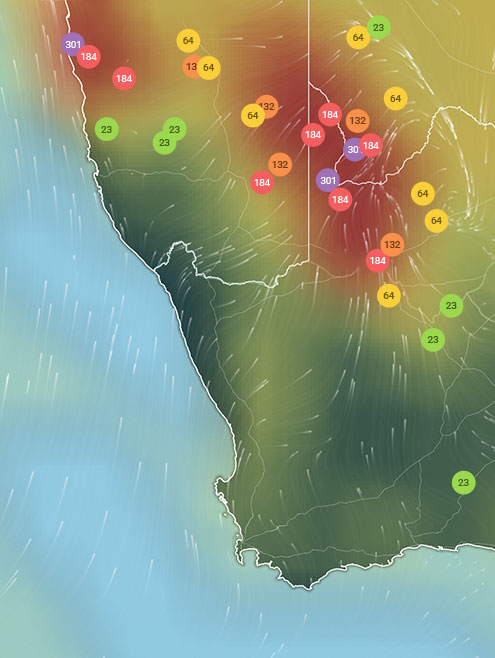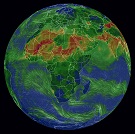Get a monitor and contributor to air quality data in your city.
14.6K people follow this city






AIR QUALITY DATA CONTRIBUTORS
Find out more about contributors and data sources| Weather | Rain |
| Temperature | 37.4°F |
| Humidity | 93% |
| Wind | 10.4 mp/h |
| Pressure | 29.6 Hg |
| # | city | US AQI |
|---|---|---|
| 1 | Warsaw, Mazovia | 47 |
| 2 | Bialystok, Podlasie | 39 |
| 3 | Koszalin, Greater Poland | 36 |
| 4 | Wroclaw, Lower Silesia | 36 |
| 5 | Gdansk, Pomerania | 33 |
| 6 | Poznan, Greater Poland | 33 |
| 7 | Rzeszow, Subcarpathian Voivodeship | 28 |
| 8 | Sopot, Pomerania | 27 |
| 9 | Kielce, Swietokrzyskie | 25 |
| 10 | Katowice, Silesia | 24 |
(local time)
SEE WORLD AQI RANKING
| # | station | US AQI |
|---|---|---|
| 1 | Bydgoszcz, Plac Poznański | 39 |
| 2 | Bydgoszcz, ul. Warszawska 10 | 33 |
(local time)
SEE WORLD AQI RANKINGUS AQI
36
live AQI index
Good
| Air pollution level | Air quality index | Main pollutant |
|---|---|---|
| Good | 36 US AQI | PM2.5 |
| Pollutants | Concentration | |
|---|---|---|
| PM2.5 | 8.7µg/m³ | |
| PM10 | 12µg/m³ | |
| O3 | 58.1µg/m³ | |
| NO2 | 10.3µg/m³ | |
| SO2 | 5.1µg/m³ | |
| CO | 0.7µg/m³ | |
PM2.5
x1.7
PM2.5 concentration in Bydgoszcz is currently 1.7 times the WHO annual air quality guideline value
| Enjoy outdoor activities | |
| Open your windows to bring clean, fresh air indoors GET A MONITOR |
| Day | Pollution level | Weather | Temperature | Wind |
|---|---|---|---|---|
| Wednesday, Apr 17 | Good 26 AQI US | 44.6° 37.4° | ||
| Thursday, Apr 18 | Good 29 AQI US | 46.4° 32° | ||
| Friday, Apr 19 | Good 45 AQI US | 48.2° 33.8° | ||
| Today | Good 36 AQI US | 44.6° 32° | ||
| Sunday, Apr 21 | Good 13 AQI US | 46.4° 32° | ||
| Monday, Apr 22 | Good 14 AQI US | 42.8° 30.2° | ||
| Tuesday, Apr 23 | Good 31 AQI US | 50° 32° | ||
| Wednesday, Apr 24 | Moderate 52 AQI US | 42.8° 39.2° | ||
| Thursday, Apr 25 | Good 38 AQI US | 44.6° 35.6° | ||
| Friday, Apr 26 | Good 32 AQI US | 53.6° 37.4° |
Interested in hourly forecast? Get the app
Bydgoszcz is a city located in the northern region of Poland, home to some 348 thousand people as well as holding the title of eighth largest city in Poland. It is well known for being rich in architecture through its impressive buildings, hosting a multitude of different styles ranging from gothic and baroque all the way through to classical and modernist. Besides this being a draw for tourists, both international and local, it is also home to many major corporations and a rising player in Poland’s economy. Due to this, there is a subsequent rise in the number of buildings present, both to house the growing population and influx of skilled workers, as well as places of business cropping up. As with any rise in industry as well as human based activity, there is a correlation with air pollution often increasing, for a number of reasons.
In 2019, Bydgoszcz was recorded with a yearly PM2.5 average of 21.7 μg/m³, placing it into the ‘moderate’ ratings bracket, which requires a PM2.5 reading of any number between 12.1 to 35.4 μg/m³ to be classified as such. This is a fairly high reading for a city located in a European country, with many months of the year coming in significantly higher than its average, due to multiple reasons regarding meteorological conditions coupled with anthropogenic activity. This reading of 21.7 μg/m³ placed Bydgoszcz into 794th place out of all cities ranked worldwide, as well as 15th place out of all cities ranked in Poland. These are quite high rankings, and indicate that the city could do much to improve its pollution levels.
Some of the main causes of air pollution in the city would be ones that increase the year round ambient PM2.5 readings such as vehicular or factory emissions, as well as others that are more seasonal in nature, and can cause significant spikes in air pollution during certain times of the year. Vehicle fumes and emissions would play a large role in the elevated PM2.5 readings, with many personal vehicles such as motorbikes or cars inhabiting the roads, with a large portion of them running on diesel fuels that put out far more chemical compounds as well as fine particulate matter than a cleaner or more sustainable alternative would.
To keep up with the energy demands of growing businesses as well as the population, power plants and factories would be going through considerably more fossil fuels such as coal in order to meet this quota. Poland has a long history of both heavy coal extraction as well as its use, or in some cases rather the overuse, or over reliance on it as a material. When more energy demands are placed on these factories, they will burn far larger quantities of coal, which just like diesel fuel, releases vast amounts of pollution into the atmosphere. Other sources of pollution would include less salient but still present ones such as construction sites or road repairs, factory effluence (fumes from whatever industrial material is being produced, aside from the coal being burnt) as well as the burning of wood or charcoal during the colder months to provide heating to homes.
Observing the data taken over the course of 2019 as a reference point in which to go by, it can be seen that pollution levels start to rise around the end of the year, although of note is that this city has fairly high levels of PM2.5 on record for the whole year, so the disparity is not too large but still present nevertheless.
The months of September through to November are when these changes are witnessed, with September coming in with a PM2.5 reading of 15.6 μg/m³. This was then followed in turn by a much higher reading of 23.6 μg/m³ in October, and then 27 μg/m³ in November and 25.9 μg/m³ in December. These elevated readings continue on into the early months of the following year, as is inevitable due to the correlation of the winter months (with massive increases in energy as well as wood burning all aiding in the buildup of air contamination). January and February both came in with PM2.5 readings of 30.7 μg/m³ and 31.7 μg/m³, making February the most polluted month out of the entire year and the period of time between October through to February of the following year the time when pollution is at its worst in Bydgoszcz.
After the peak of PM2.5 in February, the pollution levels fall somewhat, with the month of March coming in at a significantly reduced reading of 16.9 μg/m³, nearly half that of the prior month. So, in following, the months of March through to September are when the pollution levels are at their best in Bydgoszcz, free from the higher amounts of smoke, haze and particulate matter that would permeate the atmosphere in the worse months. The cleanest month of the entire year was May, which came in with a reading of 15.4 μg/m³.
With much of its pollution arising from sources such as factory emissions, vehicular exhaust as well as the burning of organic material, some of the related pollutants in the air would be ones such as nitrogen dioxide (NO2) as well as sulfur dioxide (SO2), both released in high quantities by car engines (as well as heavy duty vehicles such as trucks, lorries and buses).
Nitrogen dioxide is the chief offender here, often being found in high quantities over areas that see large amounts of traffic, as well as fine particulate matter such as black carbon also being released, a major component of soot that sees release from the incomplete combustion of both fossil fuels as well as organic material, and as such would see its release from chimney stacks, vehicles as well as factory sites. Other pollutants include ones such as volatile organic compounds (VOC's), some of which include chemicals such as benzene, xylene, methylene chloride and formaldehyde.
2Contributors
2 Government Contributors
2 stations